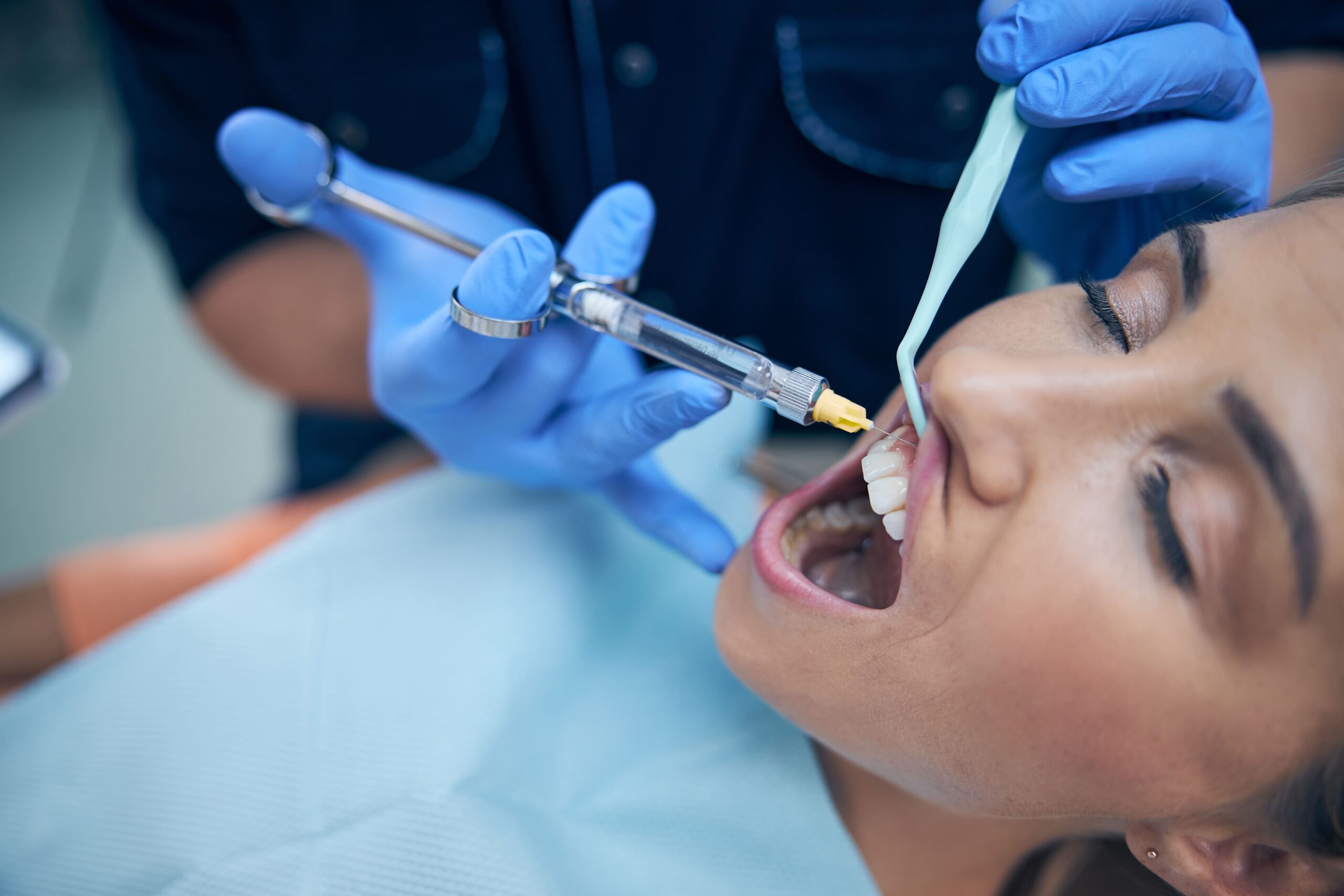We all want a healthy, bright smile, but common dental myths can sometimes lead us…

A Guide to Dental Anesthesia – Relieving Pain and Anxiety
A trip to the dentist can cause anxiety for many patients. In fact, up to 15% of Americans experience extreme dental fear that prevents them from seeking dental care. Fortunately, modern dental offices offer various forms of anesthesia to ensure your visit is as comfortable and pain-free as possible.
The key is choosing the right type of anesthesia for your particular dental procedure and needs. Common options include nitrous oxide, intravenous (IV) sedation, local anesthetic, and oral conscious sedation. Each has advantages depending on the level of sedation required and your recovery time. Most provide relaxation and pain relief while allowing you to remain conscious.
This article will overview the different anesthesia choices available so you can discuss options with your dentist. The goal is to remove anxiety from the equation, making dental treatments easy and stress-free. With the right sedation, you may be so relaxed that you fall asleep during the procedure but still arousable if needed. Work with your dentist to select the optimal anesthesia for your treatment, health history, and comfort.
Nitrous Oxide
Nitrous oxide, also known as laughing gas, is one of the safest and most commonly used sedatives in dentistry. It is administered through a nasal mask as an inhaled gas. Nitrous oxide allows you to relax and feel less anxious during minor routine dental procedures like cleanings, fillings, and simple extractions.
When inhaling nitrous oxide, you will feel slight tingling and warmth throughout your body as you enter a state of relaxation and sedation. Nitrous oxide works by blocking pain signals to the brain. You remain fully conscious but feel less anxious, and may feel somewhat detached from the procedure. Some people describe mild euphoria and laughing fits, which is where the name “laughing gas” comes from.
The effects wear off quickly once you stop inhaling the nitrous oxide. After your treatment is complete, you will breathe oxygen for 5-10 minutes to help remove any remaining nitrous oxide from your system. You should feel back to normal by the time you leave the dental office. There is no hangover effect with nitrous oxide.
IV Sedation
IV sedation, also known as intravenous sedation or twilight sedation, involves administering sedative medication intravenously into your arm or hand. This induces a sleep-like state while allowing you to respond during the dental procedure.
IV sedation is commonly used for more complex dental procedures like wisdom tooth extractions, dental implants, or gum surgery. The IV sedative makes you feel relaxed and sleepy so you won’t experience pain or remember the procedure.
The sedative is given through an IV infusion, so the level of sedation can be precisely controlled and adjusted as needed. This allows your dentist to induce a state where you will be asleep but still able to follow simple commands if needed.
The main advantages of IV sedation are that it quickly induces sedation, provides deep sedation, and is easily reversible once the infusion is stopped. There is also minimal gagging sensation.
After the dental procedure is complete, the IV sedative will be stopped. You will continue to be closely monitored as you wake up from the effects of the medication. Most people wake up feeling refreshed after about 30-60 minutes, ready to head home with minimal drowsiness. The entire recovery time is around 90 minutes.
With IV sedation you experience little or no discomfort, and generally have little to no memory of the actual procedure. It provides anxiety relief and comfort for more invasive dental work.
Local Anesthesia
Local anesthesia is administered by injection directly to the area being treated. This numbs only the specific area, like a few teeth or gums, allowing the dentist to perform small procedures like fillings while the patient remains awake.
The dentist will first clean the area, apply a topical numbing agent, and then inject the local anesthetic using a very fine needle. Patients will feel some pressure during the injection, but it is generally not painful. The numbness sets in quickly within a few minutes.
Local anesthesia wears off within a couple of hours once the procedure is complete. Patients can usually eat and drink right away after dental work done under local anesthesia. There is minimal to no recovery time needed.
This type of anesthesia is ideal for quick, small procedures like routine fillings, simple extractions, or minor gum treatments. The numbing effect is powerful but localized, allowing the patient to remain fully conscious during the procedure.
Oral Conscious Sedation
Oral conscious sedation is taken by mouth in pill or liquid form. This type of sedation is commonly used for wisdom teeth removal and other more involved dental procedures. Oral conscious sedation causes you to feel drowsy and relaxed but you remain awake and able to respond.
With oral conscious sedation, the medication typically takes effect within 15-30 minutes. You’ll feel very calm and relaxed but can still respond to questions and requests from your dentist. The level of sedation can be adjusted by your dentist based on your needs. This allows you to be sedated enough to have an anxiety-free dental procedure but not so much that you fall asleep.
Oral conscious sedation wears off after a few hours. You’ll need someone to drive you home after your dental appointment. When you get home, you’ll likely feel drowsy and may need to take a nap while the medication continues to wear off. It’s important to take it easy and follow your dentist’s recovery instructions. With oral conscious sedation, there is very little “hangover effect” the next day. You should feel normal within 24 hours.
Choosing the Right Anesthesia
The type of anesthesia used for your dental procedure depends on several factors. There is no one-size-fits-all approach, as the appropriate anesthesia depends on the procedure being performed and your individual needs and preferences.
Some of the key factors in choosing the right anesthesia include:
Type of procedure: More complex procedures like wisdom tooth extraction or dental implants require deeper sedation like IV sedation or general anesthesia. Simple procedures like cleanings and fillings only require local anesthesia. The length and complexity of the procedure impacts the anesthesia choice.
Anxiety level: If you have high dental anxiety or fear, you may opt for nitrous oxide or oral conscious sedation to help you relax. Both can ease anxiety without putting you completely asleep. IV sedation provides deeper sedation for those with extreme fear.
Doctor recommendation: Your dentist knows your dental needs best and will make anesthesia recommendations based on the procedure, your health history, and comfort level. Discuss options with your dentist to choose the right anesthesia for you.
Health history: Factors like pregnancy, sleep apnea, heart conditions, and drug allergies can limit anesthesia choices for some patients. Your dentist will select anesthesia based on your health and safety.
Cost: IV sedation and general anesthesia have higher costs than local anesthesia or nitrous oxide. Insurance may not cover sedation, so costs may influence your choice.
There is no universal approach to dental anesthesia. By considering the procedure, your anxiety, doctor input, health status, and costs, you can work with your dentist to choose the ideal anesthesia for a comfortable, anxiety-free visit.
Anxiety Relief
Many people experience anxiety about going to the dentist. The good news is there are several ways your dentist can help relieve anxiety and make you feel comfortable during procedures.
One major benefit of anesthesia is that it reduces anxiety levels. Nitrous oxide provides a calming effect that makes you feel more relaxed. IV sedation produces a state of comfort and sedation that eases anxiety. Local anesthesia and oral sedation medications also help patients feel more at ease. With anxiety diminished, dental care is much easier to undergo.
In addition to anesthesia, your dentist may offer other options to help you relax. You may be able to listen to your choice of music during a procedure. Some offices have televisions in treatment rooms to provide a distraction. Blankets and dimmed lighting can make you more comfortable. Your dentist may guide you in relaxation techniques such as deep breathing exercises. Discuss your anxiety with your dentist so they can take steps to ensure you have an anxiety-free visit. The goal is for you to feel as comfortable and relaxed as possible during dental care.
Risks Of Anesthesia Use
Though rare, there are some risks associated with dental anesthesia that patients should be aware of. All forms of anesthesia do carry potential side effects like nausea or vomiting. Some patients may also have allergic reactions to certain anesthetic agents.
One of the most serious risks with some forms of dental anesthesia is respiratory depression. This is most common with IV sedation or general anesthesia, where patients are given anesthesia intravenously and can become very deeply sedated. This can cause slowed or temporarily stopped breathing. For this reason, patients under IV sedation or general anesthesia have their breathing constantly monitored by an anesthesiologist or doctor.
Local anesthesia and nitrous oxide carry lower risks of respiratory depression. With nitrous oxide, also known as laughing gas, patients remain awake and breathing on their own. Local anesthesia just numbs a very specific area of the mouth, so there are minimal systemic effects. Still, any type of medication does carry potential risks that should be discussed with your dentist.
Keeping Pain and Anxiety at Bay
Getting dental work done often requires some form of anesthesia to keep patients comfortable and relaxed. The good news is that there are many anesthesia options available to suit different needs. Patients who get anxious about dental procedures can rest assured that modern anesthesia makes even extensive treatments easy and painless.
The various anesthesia methods each have their pros and cons. Nitrous oxide can help take the edge off anxiety, while IV sedation is ideal for more involved treatments. Local anesthesia blocks pain at the root for procedures like cavities and fillings. Oral conscious sedation is useful for people who want to remain lightly sedated.
It’s important to have an open discussion with your dentist about which option is best for your particular procedure and comfort level. There’s no reason to feel apprehensive about dental work when there are so many excellent anesthesia choices available. Taking the time to understand the alternatives can lead to a positive experience where you can relax through even complex treatments. Anesthesia empowers patients to feel peaceful and comfortable during dental visits instead of experiencing pain or anxiety.


